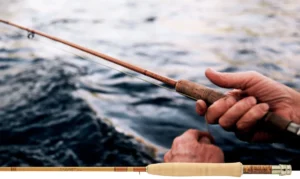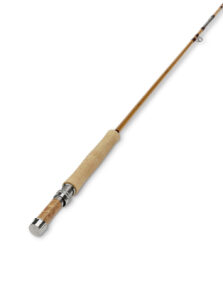
Spinoza Rod Company https://www.spinozarods.com/
Key Takeaways
-
E.F. Payne Rod Co. set the standard for handcrafted bamboo fly rods with its exceptional craftsmanship.
-
Understanding the unique tapers of vintage bamboo rods is crucial for appreciating their performance and value.
-
Payne rods are distinguished by their specific models and tapers, which are sought after by collectors and anglers alike.
-
Authenticating a Payne rod involves recognizing specific characteristics and historical details.
The Legacy of E.F. Payne Custom Bamboo Fly Rods
For those who cherish the tradition of fly fishing, the name E.F. Payne conjures up images of artistry and endurance. The E.F. Payne Rod Company, established in 1898, pioneered the crafting of bamboo fly rods that have become legendary among anglers and collectors. Each Payne rod tells a story of meticulous craftsmanship and a passion for fishing that transcends generations.
The Birth of a Fishing Legacy
It all began with Ed Payne’s vision to create a superior fly rod. He saw the potential in bamboo—a material that was strong yet flexible, capable of casting a line with precision and grace. This vision took root in the Catskill Mountains, where the rivers are woven into the landscape and fly fishing is a way of life.
Ed Payne’s commitment to quality was unwavering. Each rod was a labor of love, taking dozens of hours upon hours to perfect. When his son, Jim Payne, took over, the legacy of excellence continued. He adhered to the same exacting standards, ensuring that every rod which bore the Payne name was nothing short of exceptional.
Artisanal Techniques That Defined an Era
The creation of a Payne bamboo fly rod was both a science and an art. It began with the careful selection of bamboo, followed by the precise splitting of the canes. The artisans would then hand plane each strip to create a taper that was unique to Payne rods—a secret recipe that gave them their legendary action.
Popular 4 wt Payne Vintage Tapers For Small Stream Trout
Comparison Table:
|
Payne 7ft 1in |
Payne 100 – 7ft 6in 4wt 2pc |
Payne 200L 8ft 3pc 4wt – heavy tip |
Payne 200L 8ft 3pc 4wt – light tip | |
|---|---|---|---|---|
|
Geometry |
Hex (6) |
Hex (6) |
Hex (6) |
Hex (6) |
|
Construction |
Solid |
Solid |
Solid |
Solid |
|
Rod Length |
7 ft 6 in (=90 in) |
7 ft 6 in (=90 in) |
8 ft 0 in (=96 in) |
8 ft 0 in (=96 in) |
|
Action Length |
6 ft 3 in (=75 in) |
6 ft 8 in (=80 in) |
7 ft 0 in (=84 in) |
7 ft 0 in (=84 in) |
|
Line type |
Standard |
Standard |
Standard |
Standard |
|
Line Weight |
4 DT |
4 DT |
4 DT |
4 DT |
|
Pieces |
2 |
2 |
3 |
3 |
|
Tip Factor |
1.550 oz (4.0 x0.387 oz) |
1.550 oz (4.0 x0.387 oz) |
1.550 oz (4.0 x0.387 oz) |
1.550 oz (4.0 x0.387 oz) |
|
Tiptop |
4.0/64ths |
5.0/64ths |
4.0/64ths |
3.5/64ths |
|
Ferrule Size |
13/64 @ 45.00 in |
Fer size 12/64 @ 45.00 in |
Ferrule 1 size 9/64 @ 32.00 in. Ferrule 2 size 14/64 @ 64.00 in |
Ferrule 1 size 14/64 @ 64.00 in Ferrule 2 size 14/64 @ 64.00 in |
Dimension Table in Inches:
|
Station (in) |
Payne 7ft 1in Dimension (in) |
Payne 100 – 7ft 6in Dimension (in) |
Payne 200L – Heavy Tip Dimension (in) |
Payne 200L – Light Tip Dimension (in) |
|---|---|---|---|---|
|
0 |
0.067 |
0.064 |
0.049 |
0.044 |
|
5 |
0.091 |
0.070 |
0.071 |
0.067 |
|
10 |
0.098 |
0.086 |
0.086 |
0.086 |
|
15 |
0.116 |
0.101 |
0.101 |
0.096 |
|
20 |
0.126 |
0.116 |
0.115 |
0.110 |
|
25 |
0.144 |
0.131 |
0.129 |
0.126 |
|
30 |
0.153 |
0.143 |
0.137 |
0.133 |
|
35 |
0.166 |
0.155 |
0.152 |
0.152 |
|
40 |
0.179 |
0.167 |
0.171 |
0.171 |
|
45 |
0.196 |
0.180 |
0.187 |
0.187 |
|
50 |
0.215 |
0.191 |
0.197 |
0.197 |
|
55 |
0.227 |
0.203 |
0.208 |
0.208 |
|
60 |
0.246 |
0.218 |
0.217 |
0.217 |
|
65 |
0.266 |
0.231 |
0.221 |
0.221 |
|
70 |
0.293 |
0.244 |
0.238 |
0.238 |
|
75 |
0.309 |
0.269 |
0.253 |
0.253 |
|
80 |
– |
0.301 |
0.270 |
0.270 |
|
84 |
– |
– |
0.282 |
0.282 |
This table provides a comparison of the dimensions at each station for four rod models for a detailed analysis of their construction. Source: HexRod https://www.hexrod.net

American Museum of Fly Fishing https://www.amff.org/portfolio/jim-payne-fly-rod/
Deciphering Vintage Tapers in Bamboo Rods
Understanding the significance of vintage tapers in bamboo fly rods is akin to appreciating the nuances of a fine wine. The taper of a rod dictates its flexibility, strength, and overall casting characteristics. Vintage Payne tapers are particularly revered for their ability to present a fly with unmatched delicacy and precision.
These tapers were not arbitrary; they were the culmination of years of experimentation and refinement. A Payne rod’s taper was its fingerprint, a signature that set it apart from all others. To this day, the original Payne tapers are closely guarded secrets, passed down to a select few who continue the tradition of building these magnificent rods.
What Sets Vintage Tapers Apart?
So, what makes these vintage tapers so special? It’s a combination of factors, including:
-
The quality of the bamboo used during that era, which often came from select groves known for their superior fibers.
-
The hand-planing technique that ensured each strip of bamboo was shaped to exact dimensions.
-
The understanding of how different fishing conditions influenced rod design, leading to tapers that were tailored to specific environments.
These factors converged to create rods that were not just tools, but extensions of the angler’s intent—a harmonious link between the fisherman, the rod, and the river.
Why Vintage Tapers Resonate with Anglers
Anglers seek out vintage Payne tapers for several reasons. They are drawn to the history and the story behind each rod. But more than that, they appreciate the unparalleled performance that a Payne rod delivers. Whether it’s the smooth delivery of a dry fly to a rising trout or the gentle placement of a nymph in a tumbling run, a Payne rod does it with a finesse that modern rods often struggle to match.
These rods are not relics to be displayed behind glass; they are to be fished, to be part of the living tradition of fly fishing. And for those who hold a vintage Payne rod, they know they are holding a piece of history, a tool honed by the waters and the hands that have shaped fly fishing for over a century.
Concept to Creation: Crafting a Payne Rod
The process of creating a Payne bamboo fly rod is steeped in tradition and precision. It’s a process that hasn’t changed much since the early days because, quite frankly, perfection doesn’t need altering. The rod starts its life as a raw culm of Tonkin bamboo, selected for its density and fiber structure. From there, it embarks on a journey of transformation.
Handcrafting Process of Payne Bamboo Fly Rods
Handcrafting a Payne rod begins with splitting the bamboo into long, thin strips. These strips are then meticulously tapered using a metal form—a template that’s been passed down through the years. The tapering process is what gives each rod its action, its soul. Once tapered, the strips are glued together to form the rod’s blank.
The next steps involve wrapping the guides with silk thread, attaching the ferrules, and applying the finish. Each step is done by hand, with an attention to detail that’s become a lost art in today’s world of mass production. It’s a process that can’t be rushed, taking weeks or even months to complete.
Key Features of Payne Bamboo Fly Rods
What sets a Payne rod apart are its distinctive features:
-
The classic honey-colored bamboo, which is not only beautiful but also provides the perfect balance of strength and flexibility.
-
The silk thread wraps, often in Payne’s signature burgundy or olive, are a hallmark of the brand.
-
The use of high-quality nickel silver for the ferrules, which ensures a snug fit and smooth action when assembling the rod.
These elements come together to create a rod that’s more than just a tool for fishing—it’s a work of art.
Collectible Payne Bamboo Fly Rod Models
Within the realm of vintage fly fishing gear, certain Payne models have become highly collectible, coveted for both their fishing prowess and their historical significance.
Top Vintage Models Adored by Collectors
-
The Payne 100, known for its versatility and medium-fast action, suitable for a wide range of fishing conditions.
-
The Payne 102, a favorite for its smooth casting and ability to handle delicate presentations with ease.
-
The Payne 200, a robust model designed for larger streams and more aggressive fish.
These models represent the pinnacle of Payne’s craftsmanship, and to own one is to own a piece of fly fishing history.
Besides the specific models, collectors also value the story behind each rod. A Payne rod that has been passed down through generations, or one that has a well-documented provenance, can be worth significantly more. It’s the story that makes each rod unique, and that adds an intangible value beyond the physical object.
Identifying Authentic Payne Rod Inclusions
When assessing a Payne rod for authenticity, look for:
-
The original tube and sock, often marked with the Payne logo, which housed the rod when not in use.
-
The presence of a serial number, usually stamped on the rod, which can provide clues to its age and origin.
-
Any documentation or receipts that accompany the rod, adding to its history and authenticity.
Authenticating a Payne rod involves a keen eye and knowledge of the brand’s history. It’s a skill that comes with experience and study, but it’s essential for anyone looking to collect or invest in these timeless pieces.
Preservation of Your Bamboo Fly Rod
Preserving a vintage bamboo fly rod is about respecting the craft and the history it represents. It’s about ensuring that future generations can experience the same joy and satisfaction that comes from casting a Payne rod.
Restoration Tips for Vintage Payne Rods
Restoration should be approached with caution. It’s often best left to professionals who specialize in bamboo rod restoration. They have the tools and expertise to bring a tired rod back to life without compromising its integrity.
Because, in the end, a Payne rod is more than just a piece of fishing equipment. It’s a legacy—a connection to the past and a promise for the future. It’s a commitment to quality and tradition that deserves to be preserved. And for those who are lucky enough to cast one, it’s an experience that’s simply unmatched.

Spinoza Rod Company https://www.spinozarods.com/
Frequently Asked Questions (FAQ)
What distinguishes a Payne bamboo fly rod from other brands?
Payne bamboo fly rods are celebrated for their impeccable craftsmanship and the unique tapers that give them a legendary status among anglers. Their rods are known for a few hallmark characteristics:
-
Exceptional balance and feel that make casting effortless and precise.
-
Use of high-quality Tonkin bamboo, which provides strength and resilience.
-
Distinctive hand-wrapped silk guides that add to the rod’s elegance and functionality.
-
Custom reel seats, often made from fine woods and metals, that reflect the rod’s premium status.
These features, combined with the company’s storied history, set Payne rods apart from other brands and make them a prized possession for any angler.
How can I verify the authenticity of a vintage Payne rod?
Verifying the authenticity of a vintage Payne rod involves several steps:
-
Examine the rod for the Payne trademark, usually located near the grip or on the reel seat.
-
Look for a serial number stamped on the rod, which can provide information about its production date and model.
-
Check for the original rod tube and sock, which often bear the Payne logo and are indicators of authenticity.
-
Consult with experts or refer to Payne rod catalogs and historical documents for comparison.
Authentic Payne rods will have a level of craftsmanship and attention to detail that is difficult to replicate, so these elements are good indicators of a genuine piece.
What are the signs of a well-maintained bamboo rod?
A well-maintained bamboo rod will show signs of careful handling and regular upkeep. Look for:
-
A smooth, intact varnish finish with no cracks or peeling.
-
Clean, secure wraps around the guides with no fraying.
-
Snug-fitting ferrules that join the rod sections without gaps or wobble.
-
A straight form with no warping or bends in the bamboo.
Can modern anglers benefit from using a vintage Payne rod?
Modern anglers can indeed benefit from using a vintage Payne rod. These rods offer a unique fishing experience that differs from modern graphite rods. The slower action of bamboo allows for a more rhythmic and tactile casting, which can improve an angler’s technique and enhance their connection to the water. Additionally, fishing with a piece of history adds a layer of enjoyment and nostalgia to the angling experience.
Whether you’re a seasoned fly fisher or new to the sport, a vintage Payne rod can offer a sense of continuity with the traditions of fly fishing, as well as a reminder of the craftsmanship and artistry that go into creating a fine fishing tool.




